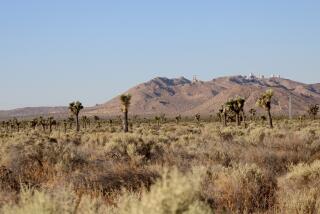Activists Blast Bulldozing of Cave for Tollway
- Share via
ORANGE — Toll-road builders have bulldozed a cave that some believe was a Native American observatory, angering those who had urged further study of the site.
Some activists are lambasting the Transportation Corridor Agencies for quietly moving ahead with the work last month, and one woman was arrested during a protest this week. However, transportation officials say they have violated no environmental regulations and their information shows that the cave was not archeologically significant.
A UC Irvine doctoral student who had studied the cave said Friday he still believes the cavern was a centuries-old observatory used to mark the winter solstice, and he criticized the transportation agencies for demolishing it Aug. 2.
“Basically they thumbed their nose at the Indians and said, ‘Your beliefs don’t count,’ ” said R.H. (Hank) Stevens, an ethnographic researcher and social sciences student.
But no proof has surfaced that the cave was indeed a solstice observatory, said a spokeswoman for the transportation agencies. She defended the decision to bulldoze the cave that lay in the path of the Eastern Transportation Corridor. “We’ve done everything according to law,” spokeswoman Lisa Telles said.
The tollway is being built in the unincorporated territory east of Orange, near Irvine Regional Park, and, when completed, it will provide a thoroughfare from the Riverside Freeway to Irvine.
Road builders complied with a request from the Juaneno band of Mission Indians that the site be excavated and findings documented, even though the study was not required, Telles said.
Workers removed such artifacts as a worked deer bone, a complete abalone shell, pecten shells and “a large amount of fire-affected” rock from the cave before it was bulldozed, officials said.
The project archeologist found nothing unusual among the artifacts, said Macie Cleary-Milan, principal environmental analyst for the agencies.
Stevens’ theory of a solstice observatory is not shared by a second archeologist who studied the cave earlier.
There is no rock art or other evidence that the cave was used as an observatory for the winter solstice, such as a pictograph hit by sunlight during the solstice, said John Romani, an archeologist who surveyed the site for the agency three years ago. But on the other hand, the data he has seen did not rule out the possibility it was an Indian ceremonial site.
Vera Rocha, who describes herself as chief of a group of Gabrielino Shoshone Indians, insists the site was indeed a sacred solstice cave.
“If they continue to destroy things like this, there will be no history to tell,” Rocha said.
Times staff writer Mark Platte contributed to this report.
More to Read
Sign up for Essential California
The most important California stories and recommendations in your inbox every morning.
You may occasionally receive promotional content from the Los Angeles Times.










